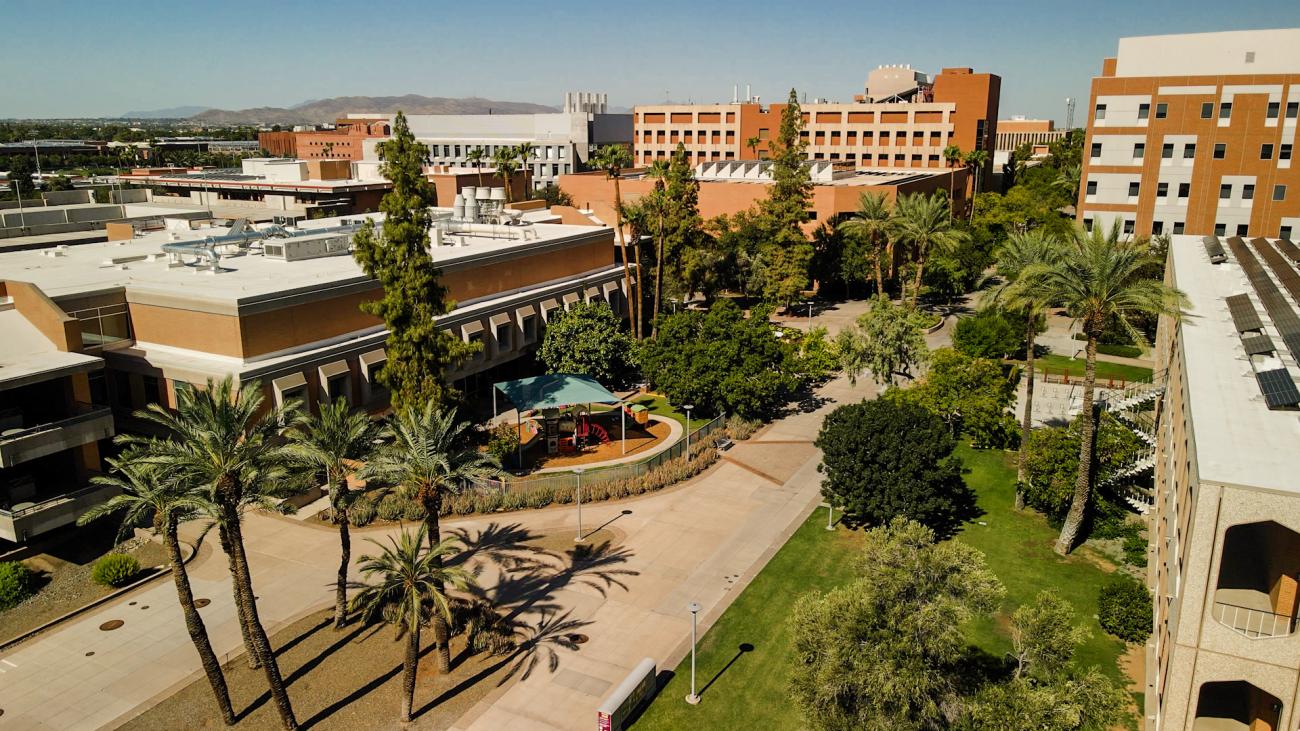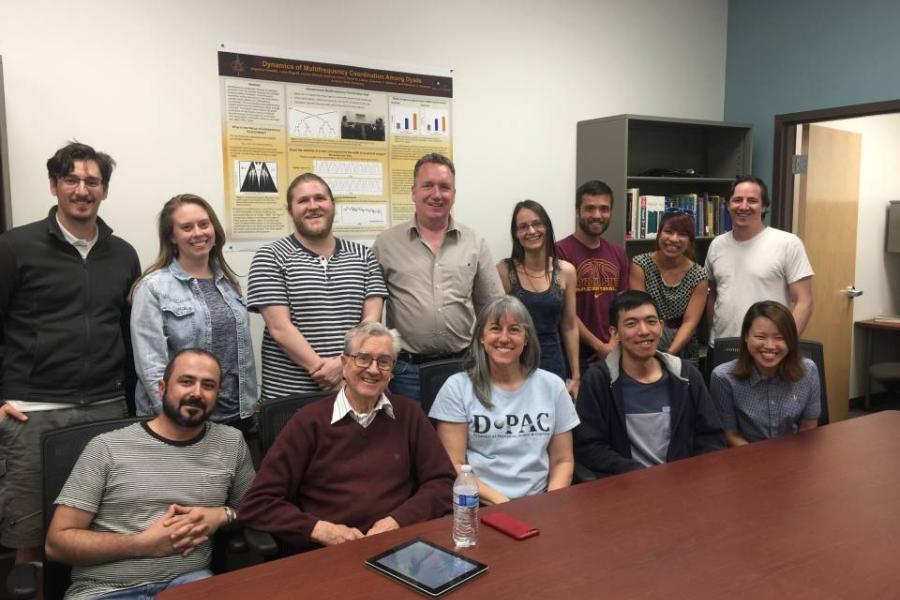
Dynamics of Perception, Action, & Cognition (Amazeen)

The Dynamics of Perception, Action, & Cognition (DPAC) lab is focused on promoting a dynamical approach to perception, action, and cognition. Our research uses the principles and tools of dynamical systems, complex systems, and ecological psychology to understand the coordination among the multiple systems and processes involved in perception, action and cognition, including: team coordination, motor coordination, coordination of physiological processes, postural control, learning and exploration, weight perception, and tool use.
Research Opportunities
We welcome undergraduate and graduate research assistants. Our research assistants gain experience in all aspects of research, including designing experiments, collecting data, working with technical data collection equipment, and performing data analysis. If you are interested in joining our team, then please contact either one of the faculty directors: Dr. Eric Amazeen ([email protected]); Dr. Nia Amazeen ([email protected]).
Lab Directors & Principal Investigators: Eric Amazeen, PhD, Associate Professor and Nia Amazeen, PhD, Professor |
Dr. Eric Amazeen's research focuses on the role of bodily movements in perception and cognition to better understand how we use movement to perceive and how cognition is influenced by the dynamics of those movements. The study of weight perception has been a particularly fruitful area of study because perceiving heaviness always begins with lifting. His research has shown that perception is tied to the dynamics of lifting and the measured activity of the muscles. The foundational role of movement dynamics is evident throughout his research on motor control and coordination in both one- and two-person movements. Curriculum vitae. |
Dr. Polemnia (Nia) G. Amazeen's research is directed at the understanding of behavior as a complex system in which the whole is not equal to the sum of the parts. She uses mathematical models to look for behavior patterns and general principles of coordination in teamwork, motor skills, and other perception-action-cognition phenomena.Dr. Amazeen’s research is funded by the National Science Foundation and Department of Defense. She serves on the board of directors for the International Society for Ecological Psychology and on the executive committee for the Center for Social Dynamics and Complexity (CSDC). In 2010, she co-authored Training Adaptive Teams, which earned the Jerome H. Ely best article award. Curriculum vitae |
Doctoral Students |
Where are they now? Our alumsAcademics:Dr. Jamie Gorman - Georgia Institute of Technology Dr. Eric Hessler - University of Minnesota, Duluth Dr. Aaron Likens - University of Nebraska, Omaha Industry:Dr. Justin Fine - Indiana University Dr. Cameron Gibbons - Boeing Dr. Andre Valdez – Argosy University Dr. Morgan Waddell: Exponent (scientific research consulting) |
Select Publications
Below are a sample of recent publications from the Amazeen DPAC research and lab. A more complete listing may be found in their curriculum vitae: Eric Amazeen CV; Nia Amazeen CV.
Underline - indicates grad student author
Gibbons, C. T., Amazeen, P. G., & Likens, A. D. (2019). Distinguishing two types of variability in a sit to a stand task. Motor Control.
Jimenez, A. A., Ochoa, D. A., Amazeen, P. G., Amazeen. E. L., & Cabrera, F. (2019). Affordances guide choice behavior between equal schedules of reinforcement in rats. Ecological Psychology.
Likens, A. D., Amazeen, P. G., West, S. G., & Gibbons, C. T. (2019). Statistical properties of multiscale regression analysis: Simulation and application to human postural control. Physica A: Statistical Mechanics and its Applications, 532, 121580.
Demir, M., Likens, A. D. Cooke, N. J., Amazeen, P. G., & McNeese, N. J. (2019). Team coordination and effectiveness in human-autonomy teaming. IEEE Transactions on Human-Machine Systems, 49, 150-159.
Gibbons, C. T., Amazeen, P. G., & Jondac, J. (2019). Thinking on your feet: An analysis of movement and cognition in a sit to stand task. Acta Psychologica, 192, 52-58.
Gibbons, C. T., Amazeen, P. G., & Likens, A. D. (2019). Effects of foot-placement on postural sway in the AP and ML directions. Motor Control, 23, 149-170.
Olenina, A.H., Amazeen, E.L., Eckard, B., & Papenfuss, J. (2019). Embodied cognition in performance: The impact of Michael Chekhov’s acting exercises on affect and height perception. Frontiers in Psychology.
Waddell, M.L., & Amazeen, E.L. (2019). Focus of attention modifies contributions to perceived heaviness. Research Quarterly for Exercise and Sport.
Amazeen, P. G. (2018). From physics to social interactions: Scientific unification via dynamics. Cognitive Systems Research, 52, 640-657. https://doi.org/10.1016/j.cogsys.2018.07.033
Demir, M., Cooke, N. J., & Amazeen, P. G. (2018). A conceptual model of team dynamical behaviors and performance in human-autonomy teaming. Cognitive Systems Research, 52, 497-507.
Waddell, M.L., & Amazeen, E.L. (2018). Leg perception of object heaviness. Ecological Psychology, 30, 314-325.
Waddell, M.L., & Amazeen, E.L. (2018). Lift speed moderates the effects of muscle activity on perceived heaviness. Quarterly Journal for Experimental Psychology, 71, 2174-2185.
Amazeen, P. G., & Amazeen, E. L. (2017). A systems approach to perception and action. Ecological Psychology, 29 (3), 213–220. https://doi.org/10.1080/10407413.2017.1330119
Gorman, J. C., Amazeen, P. G., Crites, M. J., & Gipson, C. L. (2017). Deviations from mirroring in interpersonal multifrequency coordination when visual information is occluded. Experimental Brain Research, 235 (4), 1209-1221.
Waddell, M.L., & Amazeen, E.L. (2017). Evaluating the contributions of muscle activity and joint kinematics to weight perception across multiple joints. Experimental Brain Research, 235, 2437-2448.
Waddell, M. L., Fine, J. M., Likens, A. D. Amazeen, E. L., & Amazeen, P. G. (2016). Perceived heaviness in the Context of Newton’s 2nd Law: Combined effects of muscle activity and lifting kinematics. Journal of Experimental Psychology: Human Perception and Performance, 42 (3), 363-374.
Fine, J. M., Likens, A. D., Amazeen, E. L., & Amazeen, P. G. (2015). Emergent complexity matching in interpersonal coordination: Local dynamics and global variability. Journal of Experimental Psychology: Human Perception and Performance, 41(3), 723-737.
Likens, A. D., Fine, J. M., Amazeen, E. L., & Amazeen, P. G. (2015). Experimental control of scaling behavior: What is not fractal? Experimental Brain Research, 233, 2813-2821.
Hessler, E. E., & Amazeen, P. G. (2014). Learning and transfer in motor-respiratory coordination. Human Movement Science, 33, 321-342.
Likens, A. D., Amazeen, P. G., Stevens, R., Galloway, T., & Gorman, J. (2014). Neural signatures of team coordination are revealed by multifractal analysis. Social Neuroscience, 9, 219-234.
Amazeen, E.L. (2014). Box shape influences the size-weight illusion during individual and team lifting. Human Factors, 56, 581-591.
Fine, J.M., Ward, K.L., & Amazeen, E.L. (2014). Manual coordination with intermittent targets: Velocity information for prospective control. Acta Psychologica, 149, 24-31.
We are collaborating with quantitative psychologist, Stephen West, to develop new dynamical methods that identify the scale and time course of influence across bodily subsystems both within and across people. Our first publication from this effort appeared in Physica A.

We celebrated 20 years in 2020 of our ongoing seminar entitled Dynamics of Perception, Action, and Cognition (DPAC). DPAC welcomes broad participation from faculty and students from all four of ASU’s campuses. We are proud to have never repeated a topic over these 20 years, but any participant can rattle off a list of favorites. Two goals are to: (1) read the broad literature required by a dynamical approach to perception, action, and cognition; and (2) hone our critical debate skills. It’s just what you imagined a graduate seminar to be. Come join us... all are welcome!

We are committed to teaching students of all ages about the use of dynamics in psychology, and so we value community outreach to local schools, including this group of students from refugee families.



